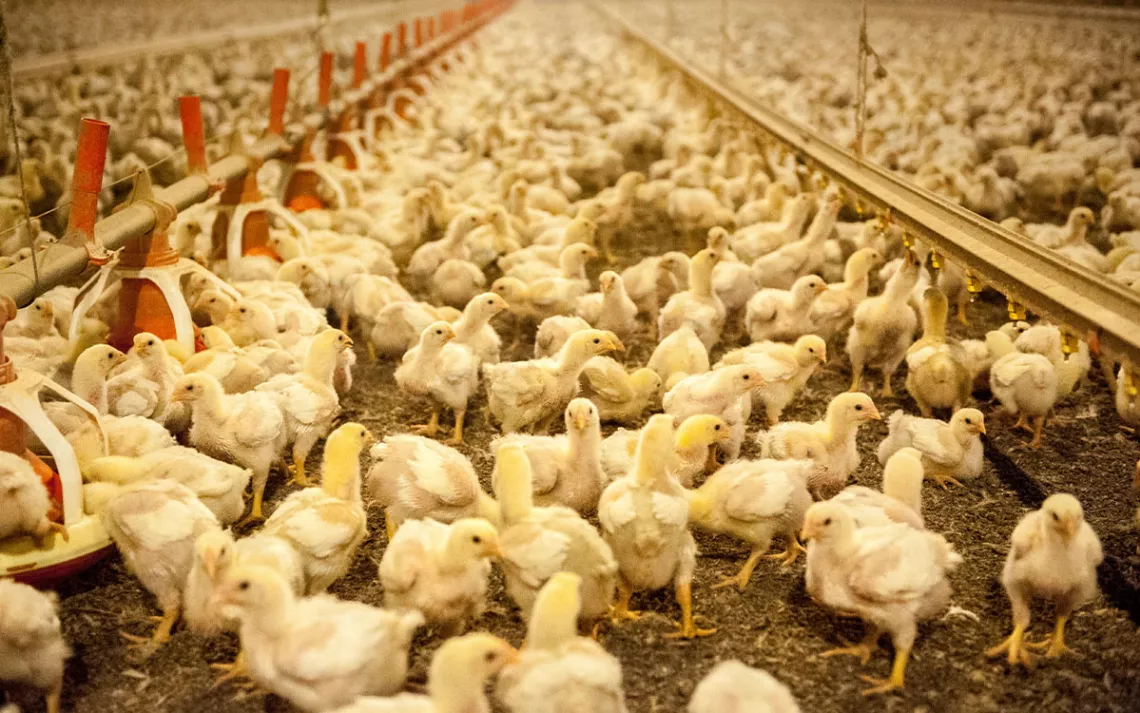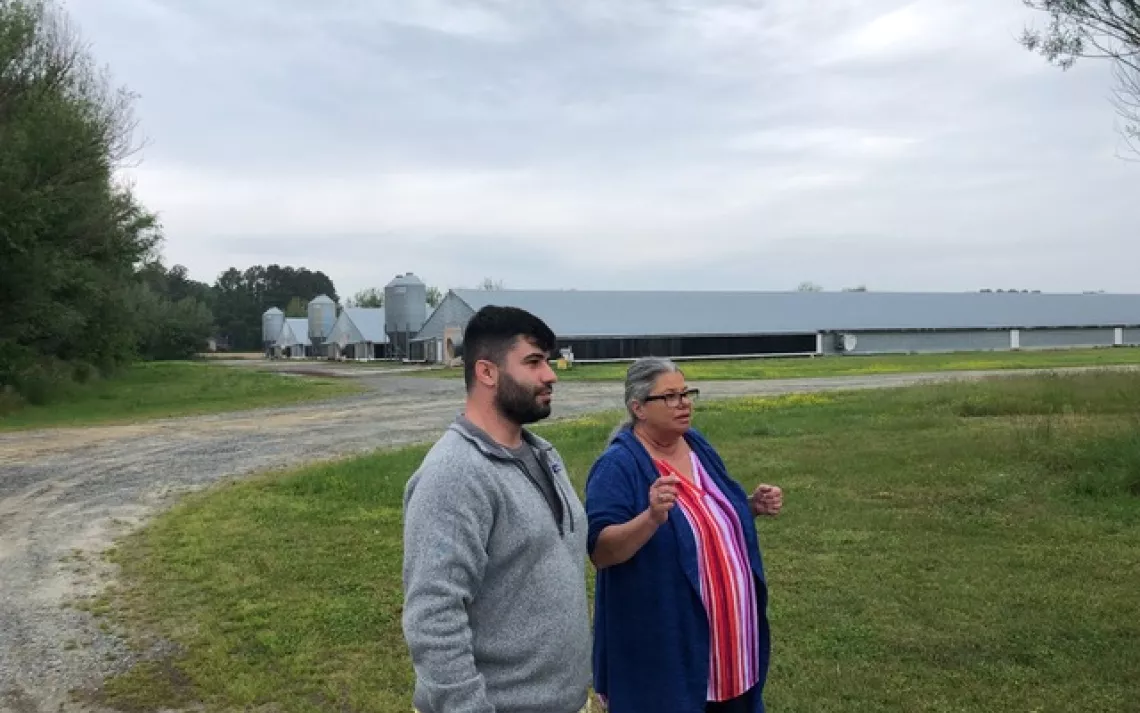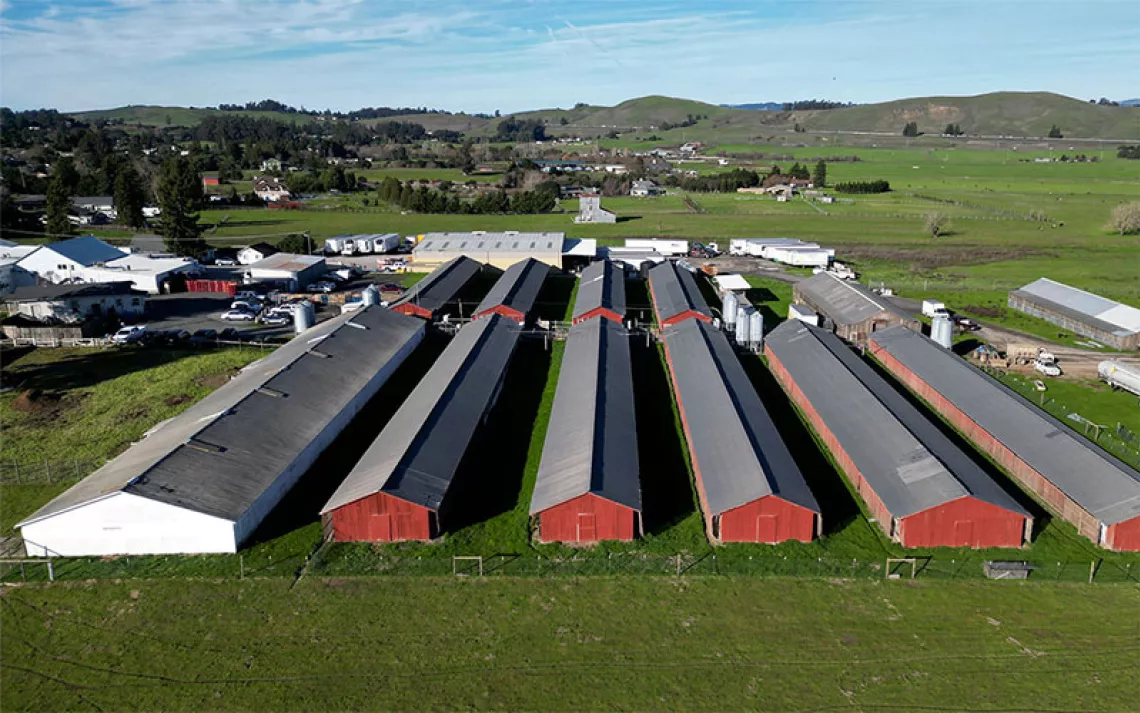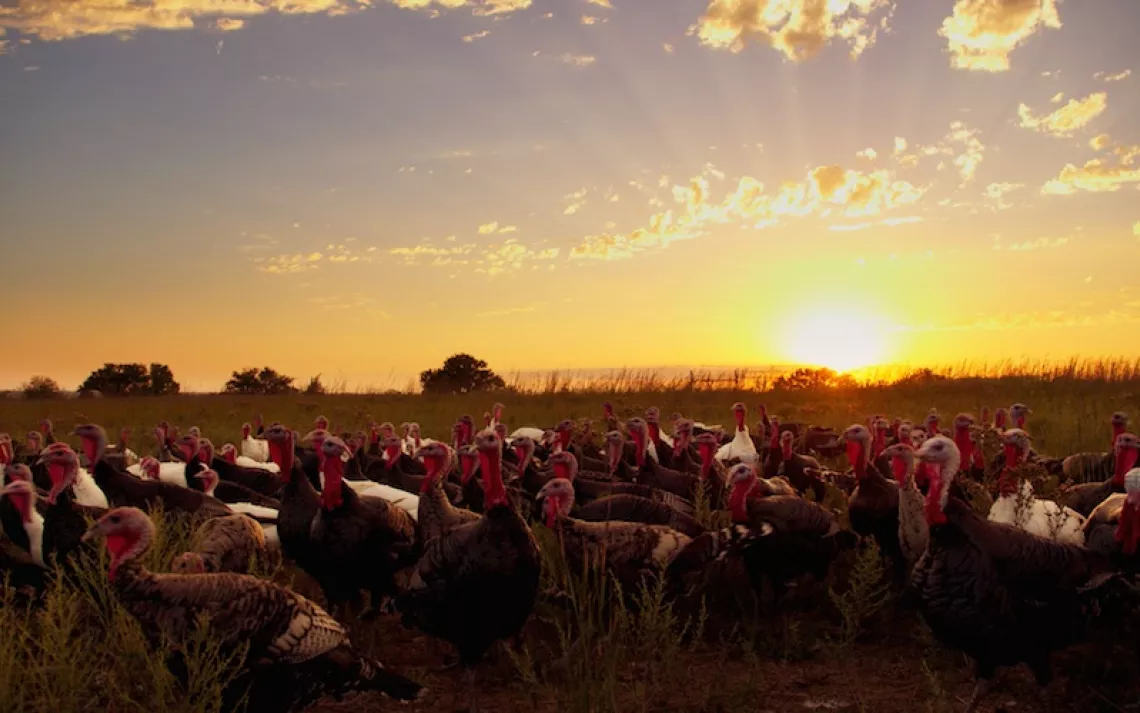Mega CAFOs on the Chesapeake
Chicken farms housing millions of animals threaten a fragile ecology

Photo by Edwin Remsberg/VWPics via AP Images
This article has been updated since publication.
On a drizzly day in May, Maria Payan walked along a country road in Somerset County, Maryland, near her home. On one side of the road was a white house with a peaked roof and an American flag flying from the porch; a ride-on toy tractor was parked by the front steps. On the other, a row of six long, windowless metal buildings housed tens of thousands of chickens. “Oh, the smell is so bad,” Payan said. “Can you imagine living with this every day?”
The houses on this quiet stretch of road are hemmed in on all sides by industrial chicken farms—all together, 30 chicken barns, each holding 50,000 animals at a time, new chicks replacing the fattened-up animals every two months or so. In roughly three square miles near the town of Princess Anne, 7.5 million chickens are raised and trucked to slaughter every year.
In the past decade, hundreds of these enormous poultry farms have sprung up on the flat, low-lying Eastern Shore of Maryland, and on the sliver of Virginia that encloses the lower Chesapeake Bay. Most of the land in these rural counties is zoned as agricultural-residential. Half a century ago, that meant a picture-book farm with a dozen cows and a few chickens scratching in the yard, surrounded by fields of corn and hay. Today, Payan said, there’s nothing to prevent an absentee owner from building a dozen sheds and raising animals under contract with a giant agriculture corporation like Perdue or Tyson, just a few hundred feet from someone’s front door, where they foul the air and local waterways. That’s why she cofounded the Sussex Health & Environment Network with her son to rein them in.

Maria Payan with her son Michael. | Photo courtesy of Tracy Tullis
In August, the Environmental Protection Agency denied a petition filed six years ago by dozens of organizations from 15 states—representing small farmers, immigrant workers, food safety, and the environment—demanding stronger regulations of confined animal feeding operations (CAFOs). The EPA agreed instead to “holistically evaluate and improve” its rules after a 12-to-18-month study. Though frustrated by the additional delay, advocates in rural communities from Oregon to Iowa to North Carolina continue to press their case for clean air and clean water—and for bans on the expansion of industrial meat farms.
The chickens housed on the Delmarva Peninsula’s CAFOs produce millions of tons of “litter” (soiled bedding and feathers as well as manure) each year—far more than can be safely spread on nearby fields, as small-scale farmers traditionally have done. When too much is applied to the land, especially on fallow fields and frozen ground, excess nitrogen and phosphorus leaches into groundwater, spills into ditches and streams during rainstorms, and ultimately flows into the Chesapeake Bay.
But runoff is not the only way these operations contaminate surrounding lands and waters. Sacoby Wilson, an environmental health scientist at the University of Maryland School of Public Health who studies industrial farm pollution, notes that contamination of well water by nitrates from manure is linked to “blue-baby syndrome” and decreased cognitive function in children.
He says the farms are a significant source of airborne contaminants as well. The poultry sheds are fitted with enormous fans that pull the air out so the animals don’t suffocate on the ammonia rising from their own excrement. The fans operate day and night, blowing particulate matter, ammonia, and volatile organic compounds (VOCs) into neighbors’ yards. These emissions burn the eyes, nose, and throat, and are linked to asthma and other respiratory diseases. Children and elderly people are particularly vulnerable.
The Delmarva Peninsula’s CAFOs are concentrated in areas that are low-income, Wilson’s research shows; in Delaware and to a lesser extent in Maryland, they tend to set up in areas where the majority are people of color. The poverty rate of Princess Anne, for example, is twice the state’s average, and two-thirds of the population is Black. Yet these industrial chicken farms—and industrial farms across the country—enjoy exemptions and loopholes that allow them to evade federal regulation of industrial pollutants.
CAFOs nationwide are designated “point sources” of water pollution and are subject to regulation under the Clean Water Act. But if manure flows into a nearby stream during a heavy rain, that’s considered “agricultural stormwater” and is therefore exempt. Industrial farms can therefore claim they are not polluters and can operate without a Clean Water Act permit. According to EPA records, fewer than 30 percent of approximately 21,500 large CAFOs in the US operate with federal water pollution discharge permits—which means thousands of CAFOs across the country operate beyond the scrutiny of the EPA. Experts say that’s probably an undercount, since the EPA acknowledges it does not know how many CAFOs exist and where they are.
Regulation of air pollutants from the farms is also lax. In 2005, the EPA struck a deal with thousands of factory farms, exempting them from the Clean Air Act in exchange for their helping to fund a two-year study of air emissions. The “air consent agreement” was purportedly the first step toward monitoring and regulating air pollution from industrial farms, but the EPA never finalized air pollution rules for CAFOs and the amnesty was never lifted: Eighteen years later, thousands of CAFOs remain exempt from federal clean air laws.
Oversight by the Maryland Department of the Environment is likewise “minimal and ineffective,” according to a 2021 report by the nonprofit Environmental Integrity Project. More than half the CAFOs whose records the EIP was able to review in 2019 admitted in their annual reports to the state that they had applied more manure to fields than state law allows, yet none of them were fined. Eighty-four percent of poultry operations inspected between 2017 and 2020 by the MDE failed, and more than half of those failed the follow-up inspection. Yet only 4 percent were fined, and most poultry facilities are never inspected at all.
When Michael Payan was young, the family lived in rural Pennsylvania, surrounded by big dairy, pig, and chicken farms. Michael, now 24, showed photos of himself when he was about eight: Fresh out of the bath, red blisters had spread across his back. The family believes their well water was contaminated by poultry litter and the chemicals used to disinfect the sheds. “We knew what rural America was supposed to be like,” Michael said. “And that wasn’t it.”
When they moved to Sussex County, Delaware, eight years ago, they were relieved to leave all that behind. But they soon heard about large chicken producers buying up farmland nearby, and Maria found herself on the front lines of a battle with a powerful local industry. Maria and other advocates have been fighting for years to tighten regulations and halt the growth of the industry. A proposed moratorium on new or expanded CAFOs in Maryland was defeated in the state legislature in 2020, and the Community Healthy Air Act, which would have required the state to monitor air emissions near chicken farms and to assess public health risks, failed even to make it to a floor vote in the General Assembly three years in a row. “The objection from industry was that we have no data,” Maria said. “So we said, let’s collect the data. But then the industry lobbies against [doing that].”
Advocates and public health scholars decided they would collect the data themselves. In a collaboration with researchers at the Johns Hopkins Bloomberg School of Public Health, the Payans have begun placing monitoring devices that measure particulate matter and other emissions near large poultry operations. The hope is that the information will lead to requirements for simple fixes like biofilters, ammonia scrubbers, and bigger setbacks between CAFOs and private houses.
But it’s clear to Maria and Michael that real solutions will require scaling back industrial agriculture. It’s pretty simple, Michael said: “You don’t have more animals than your land can handle.”
 The Magazine of The Sierra Club
The Magazine of The Sierra Club



